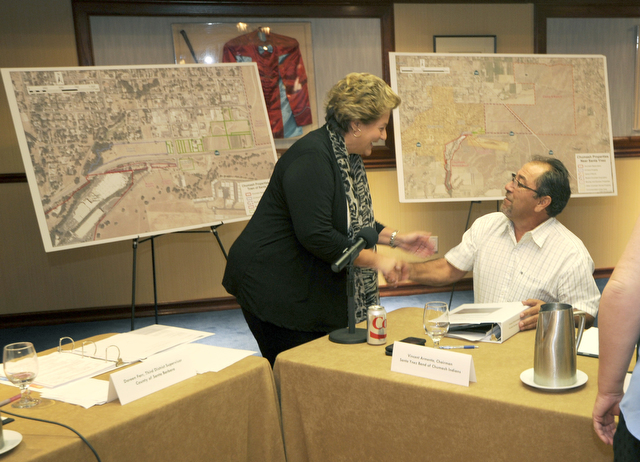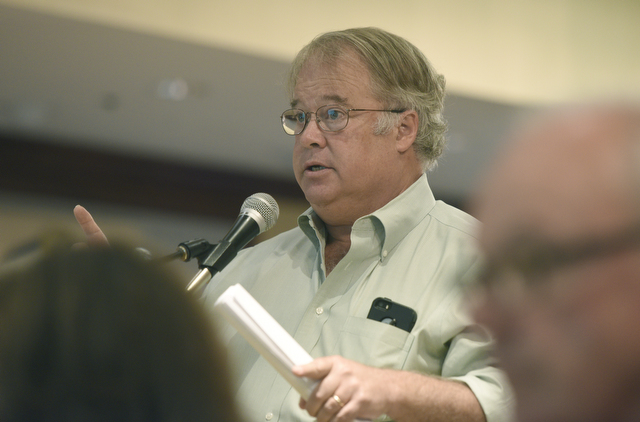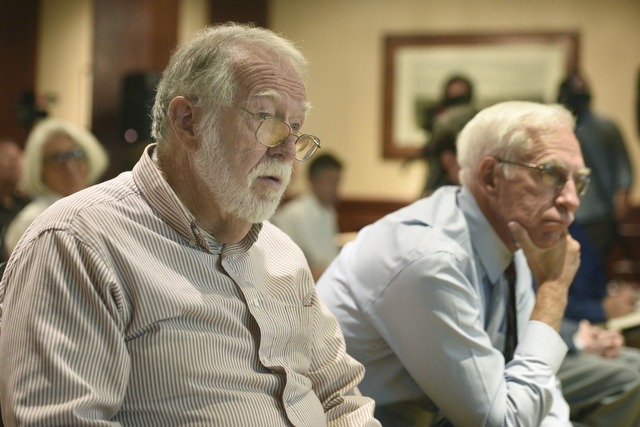Chumash Leaders and County Officials Meet
For the First Time in a Decade, Chumash and County Discuss Future Development

For the first time in a decade, the Santa Ynez Band of Chumash Indians formally met Thursday with Santa Barbara County officials for a public meeting that turned out to be much more cordial than past encounters. Nothing officially happened, but the two sides laid the groundwork for upcoming talks about annexation, financial agreements, and properties of interest, including Camp 4, the Mooney and Escobar properties, and the so-called “triangle property.”

Thursday marked a so-called government to government meeting between tribal leaders and county elected officials — long sought after by the tribe. Two years ago, the supervisors — in a split vote with Salud Carbajal and Steve Lavagnino dissenting — decided not to engage in such talks with tribal leadership. The decision to have the meeting last week at the Santa Ynez Valley Marriot stemmed from a Indian, Insular and Alaska Native Affairs subcommittee hearing in Washington, D.C. three months ago, when its chairman Don Young flatly told county CEO Mona Miyasato to formally work with tribal leaders. Otherwise he threatened to move forward a bill known as HR 1157 that would place their 1,400-acre Camp 4 property into reservation land, thereby bypassing the Bureau of Indian Affairs (BIA) application currently tied up in an appeal.
At the table Thursday were Supervisors Doreen Farr and Peter Adam — who have had a prickly relationship with tribal leaders in the past — and Chairman Vincent Armenta and Vice Chairman Kenneth Kahn. Everyone was on their best behavior, a fact subtly referenced by Chumash attorney Sam Cohen who, after being handed a laser pointer, said, “Everyone has been so helpful, thank you.” For the most part, everyone emphasized future goals rather than past problems.
That said, Cohen started the meeting by walking through points of a draft agreement the tribe said they presented to former CEO Chandra Waller in 2011. That agreement would require the county to support the annexation of Camp 4 in return for $1 million annually for 10 years in lieu of taxes. It included a limited waiver of sovereign immunity so that the county could enforce the deal in federal or state court, Cohen said. Farr said she had never seen the terms document, and it was unclear if it was ever distributed to all of the supervisors.

“I think a lot of things have changed,” Adam said, noting many more highlighted parcels that Chumash own on the map. Earlier this summer, the Chumash purchased the 350-acre “triangle property” located next to Camp 4 and west of Highway 154. Vice Chairman Kahn said an application had not been submitted to annex that property, though he did not know its long-term plan. In August, the tribe notified the supervisors an application had been submitted to place the two-acre Mooney and Escobar properties into trust.
As for Camp 4, Cohen said the plan is to build 143 houses, a health clinic, a wastewater treatment plant, and an administration room used solely by tribal members. It’s unclear when the BIA appeals process will be completed, but Armenta said he is confident the land will ultimately be brought into trust. (The late Fess Parker named the property Camp 4, Cohen said, but “we still can’t figure out why.”)
When asked by both supervisors what the long-term vision for the tribe is, Armenta said, “The overall goal is to understand the need for land.” “It’s important,” he went on, noting the need for cities, such as Goleta, Lompoc, and Santa Maria, to grow. “It’s absolutely no different.”

When cities grow, counties shrink, Adam argued, and cities are required to pay some amount to the county for the rest of time. “What’s the tribe’s intent over the next 100 years?” Peter asked, noting he does not expect an answer today. “How big does it get?”
Armenta said equally important is what is tolerable for the county. But a cooperative agreement, he said, could mitigate the loss in tax revenue. He mentioned UC’s recent purchase of three Tropicana housing properties, taking money off the tax rolls. (Farr later said all of the entities that will lose tax dollars from that purchase will be going to the university to seek an agreement.)
Before half of a dozen public commenters spoke, Armenta noted it would be important for the tribe to know what exactly the county would accept or not accept in terms of a payment agreement, an issue that will be discussed at the next meeting.
The first public speaker, POLO (Preservation of Los Olivos) attorney Jim Marino, said the tribe is a shrinking entity as it used to have 150 members and now it only has 143. The only way it will get bigger, he argued, would be if it changed its requirements for members to be one-eighth Chumash rather than one-fourth, which could quadruple the size of the tribe. One of the final speakers commended the subcommittee on the progress that has already been made.
The next meeting, which is an ad hoc subcommittee and can take no action, is scheduled for October 19 at 9 a.m., and everyone will return to the same place.



